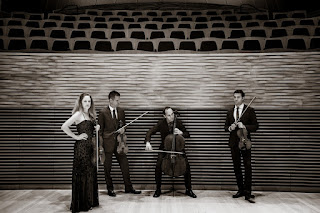A long time to come into the sun: St. Lawrence String Quartet covers Haydn's opus 20
 |
| The St. Lawrence Quartet in a soberer setting |
Making something extra special for the local return of the St. Lawrence Quartet had to take into account the disruptions of the pandemic. But four years after the idea came forward at the instigation of John Failey, a concert covering Joseph Haydn's epochal six quartets designated Opus 20 came to fruition Sunday afternoon.
The cool, sun-drenched April day turned out to be perfect for the presenting Ensemble Music Society to take up temporary residence at the Woodstock Country Club. On the program, aptly enough, were all six of the so-called "Sun" quartets. The nickname derives from the title-page illustration of a 1779 Amsterdam edition of the masterpieces, seven years after their composition.
An ensemble with a distinctive profile involving extraordinary collective elan, this quartet seems well-positioned to extend its reputation for capturing what's essential about Haydn's foundational contribution to the genre. In Opus 20, the individuality and brilliance of the Austrian creator abound, and, with its electrifying internal rapport, the St. Lawrence Quartet represented Haydn's essential qualities fully over the course of three hours (with two intermissions during which refreshments were served).
Though sometimes put in an alcove of honor by posterity, representative of classical restraint in music, Joseph Haydn was seen by his contemporaries, both fellow composers and music-lovers, as a modern composer of unusual breadth and power. The first biographical account, by G.A. Griesinger in 1810 (the year after Haydn's death) has this account of his music: "Original and abundant ideas, deep feeling, fantasy wisely controlled by penetrating study of the art, skill in the development of an idea basically simple, calculation of effect by a clever distribution of light and of shadow, pouring forth of the slyest humor, an easy flow and free movement — these are the qualities that distinguish Haydn's earlier and latest works alike."
All those facets were illuminated in the visiting quartet's representation of a string-quartet output that paralleled the "storm and stress" era in Haydn's symphonic writing. First violinist Geoff Nuttall overflowed with enthusiasm in oral program notes that expanded upon his succinct notes in the printed program. He was inspired by both the "how-to-listen" and "why-listen" sides of audience appreciation.
Looking backward as well as forward, Haydn revived counterpoint, giving it a fresh expressive manner, and pioneered new textures in string quartet writing. The wit often pointed to in his music was sometimes rather unbuttoned for a master seen as the epitome of classicism. The unconventional accents in the minuet movement of No. 4 in D major, for example, make this much-honored, often sedate dance form quite undanceable, as Nuttall pointed out before the second part of Sunday's concert.
In the St. Lawrence's performance, the firm bond between emotion and rhythmic precision in the fugal finale (one of three in the set) of No. 6 in A major turned out to be characteristic of the five pieces to come as well. That introductory reading of the Opus 20 quartets forced the listener to get used to the hyperphysical way of delivering the music characteristic of Nuttall and, to a lesser degree, his second-violin colleague, Owen Dalby. With Nuttall, one foot or the other would often leave the floor briefly, there were torso twists, and facial expressions ran the gamut. At the restrained end of the spectrum was violist Lesley Robertson, as cellist Christopher Costanza mediated between the two extremes within histrionic norms.
Soon I concentrated visually on the rest of the quartet, catching the first violinist only in my peripheral vision. That worked slightly, as I could infer how Nuttall was moving from the intense focus I could hear in how he played. That's all to the good; observing performers' body language is part of the joy of concert-going, and when it borders on distraction, you can intuit it. And it's worth emphasizing that the whole quartet sounded musically engaged in a common purpose around whatever the scores seem to suggest. Nuttall's characteristic dynamism betrayed him only a little bit in the last of the quartets, during the minuet of No. 2 in C major, when his intonation lost some of its pristine quality.
"Affettuoso" (tender, warm, emotional) as a direction for two of Haydn's Opus 20 slow movements points the way toward the deepest reaches of Haydn's temperament, which attains sublimity and simplicity alike in the cavatina of No. 5's third movement. In that movement, part of the genius is the relevance of the gingerbread figuration that persistently decorates the plaintive melody. It's a way of saying that sometimes beneath the most direct lyrical expression lies a tangle of complicated emotion.
In that connection, it's worth remembering a provocative arts op-ed in the New York Times during the lavish bicentennial observances of Mozart's death in 1991. "Those who began to call Haydn and Mozart Classical were motivated not only by admiration and the desire to cultivate and preserve their music, but also by conservative anti-Romantic feelings," James Webster writes.
Later in the 19th century, he goes on, the idea of a classical style was given granitic firmness by anti-modernists. As can be observed today, cultural politics often shifts our understanding of an art's essence. Thus it used to be with "Papa" Haydn, though the truth of his originality and spirit of adventure is easy to appreciate in such performances as the St. Lawrence offered here of the "Sun" quartets.
The likes of what the Ensemble Music audience heard should not be taken as a species of California dreaming by the Stanford University-based group. Haydn himself said that he was forced to become original in isolated service to his patron at the Esterhaza estate far away from Vienna; he certainly knew how to take the cue and let his genius run with it. The St. Lawrence rates high among musicians who can represent that for our times.



Comments
Post a Comment